If there was ever a tale of two cities it has to be Kaş and Kalkan. Both picturebook pretty, with cobbled streets and bougainvillea-draped old stone houses, the two became hugely popular with holidaying Britons in Antalya when mainstream tourism began to gather pace there in the early 1990s.
When I first visited in 1994, Kalkan was still small, and Kaş – half an hour’s drive away along the vertiginously beautiful coastal road – was the bigger, livelier sibling. In those days, Kaş was where you went for a proper night out – inevitably ending in a knuckle-whitening taxi journey back in the early hours.
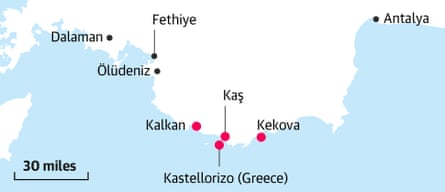
In the intervening 30 years, much has changed. Kalkan has grown into a kind of Turkish Monte Carlo, beloved of Britons (Wadebridge-on-Sea, someone said to me recently, having visited for the first time), with hundreds of restaurants, thousands of villas and a well-heeled air that sees £300 handbags fly out of the door before the first cocktails have been drunk. Kaş, on the other hand, remains remarkably unchanged; still a working town, with a tangle of atmospheric old streets and a boat-lined harbour. It also has its fair share of luxury villas and boutique hotels, but these are almost all found on the Çukurbağ peninsula, four miles out of town.
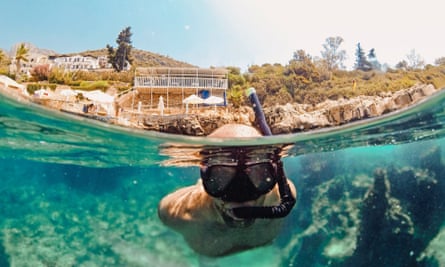
While I still love Kalkan, Kaş is the place I go to for a properly Turkish break. Staying on the peninsula offers a real sense of peace and escape, although the lack of any bus service means relying on taxis – of which there are many – or self-drive. Both Simpson and Vintage offer villas on the peninsula, while the Discerning Collection offers two hotels, the Mandalina Suites and the Deniz Feneri Lighthouse, both ideal for a romantic getaway rather than a family week, with direct access to the sea. If you want to be in the heart of town, Hotel Sonne (doubles from £56 B&B) makes a comfortable, affordable base.
Like Kalkan, Kaş is short on beaches; instead, a series of beach clubs fringe the town’s coastal strip, offering the chance to set up camp for the day, with sunbeds on over-water decks, usually attached to a restaurant or cafe. If I want to be in town, I usually head to Leymona Beach, handily located just a few minutes’ walk from the main harbour, or Kaş Beach, where the frozen margaritas are the perfect way to glide from late afternoon into the warm, sun-drenched evening.
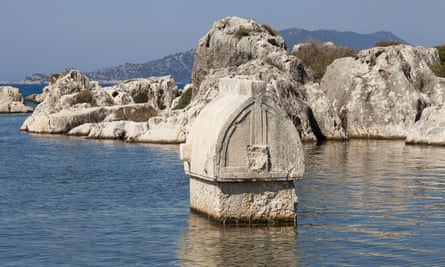
Although it’s possible to spend a week lazing on a variety of sunloungers and doing little else, Kaş has positioned itself in recent years as something of an activities hub. Dive boats glide out from the harbour each morning, offering everything from Padi courses to refresher programmes and advanced open-water dives (subaquadive.com is generally considered the best). Bougainville Travel caters for soft adventurers, with kayaking trips and Jeep safaris, as well as those looking for more hardcore thrills, such as canyoning through a series of spectacular gorges.
My favourite day out is a boat trip to Kekova island, most famous for the remains of the ancient city of Dolikisthe, lost to the sea after an earthquake in the second century AD. It’s wonderful to swim through crystal-clear water with a ruined Byzantine church shimmering eerily beneath you, and, although you get to see more of the ruins if you choose to kayak over them, for me, snorkelling is the best way to really get a sense of what would once have been an imposing trading city. On the mainland opposite Kekova is Kaleköy, where there are further partly submerged relics.
Perhaps one of the most surprising things about Kaş is its proximity to Greece – or at least the Greek island of Meis/Kastellorizo (Turkish/Greek), one of the smallest in the Dodecanese archipelago, just half an hour across the water. It’s an easy day trip by ferry, although it’s best to book in advance – and leave plenty of time for the convoluted passport wrangling that needs to be completed before you leave Turkish shores.
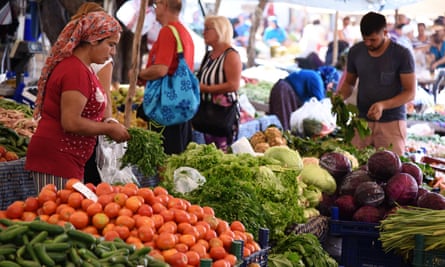
The island’s size makes it easy to explore in a few hours – boat taxis leave from the harbour for Aya Georgio beach and the spectacular Blue Cave – although I rarely do much but potter between the neoclassical mansions that line the harbour, pristine in shades of duck-egg blue and butter yellow. Lunch is inevitably a long, slow affair, taken at one of the waterfront restaurants – a little pricier than those in the backstreets, but worth it for the view back across to the rooftops of Kaş, clustered on the other side of the water.
However much I love Kaş, it’s impossible not to visit Kalkan while I’m there. The road clings to the mountainside, with hairpin bends sheering down to the sea below and views that could teach the Amalfi coast a thing or two. Time was, I’d stop for a dip on Kaputas – a stunner of a beach, sandwiched between two cliff faces – but its recent status as an Instagram favourite means if you visit between 10.30am and 5pm you’ll struggle for both a parking space and a lounger. Instead, I time it for a sunset drink and dinner, usually at the Blue Marlin, a small, unfussy restaurant tucked away on the harbour that does the best meze in town.
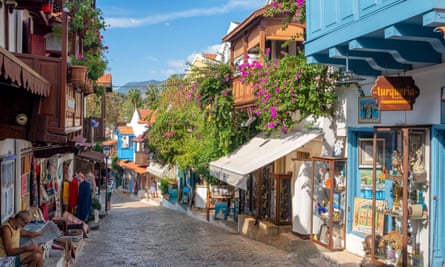
Eating out in Kaş is wonderfully relaxed compared with Kalkan, where the restaurant scene is almost gladiatorial. In Kaş, most restaurants still serve traditional Turkish dishes, with meze trays stacked in cold bars, and fresh fish piled on ice. It’s hard to go wrong, but I usually try to get a table at Beyhude Meyhane or Meydan, while Oburus Momus is my go-to if I’m with friends who are vegetarians or vegans. Kaş has a clutch of live music bars – Echo is good, if always busy – but it’s more of a mellow-tunes kind of vibe than a serious party town.
Even after 25 years of visiting Kaş, there are still plenty of things I haven’t done. I keep promising to walk a section of the Lycian Way and white‑water raft through the Toparlar canyon, or (less convincingly) take the opportunity to paraglide off Mount Assas. Somehow, there are always more enticing things to do, like sitting in the town’s leafy Çay Bahçesi (tea garden) on the main square and watching the world go by – or bartering for everything from T-shirts to spices at the frenetic Friday market, arguably the best in the region.
But perhaps my favourite thing of all is to get up early, pick up tea and simit from the Aysun Pastahanesi (on Bahçe Sokak) and sit on the harbour wall, watching the town slowly wake up, exactly as it’s done for decades. Tourism has brought much to Turkey since my first visit in the 1990s – fortunes made, resorts developed, European tastes catered for – but in Kaş, at least, it’s the lack of change, its wonderfully undiluted Turkishness, that makes it such a gem.

